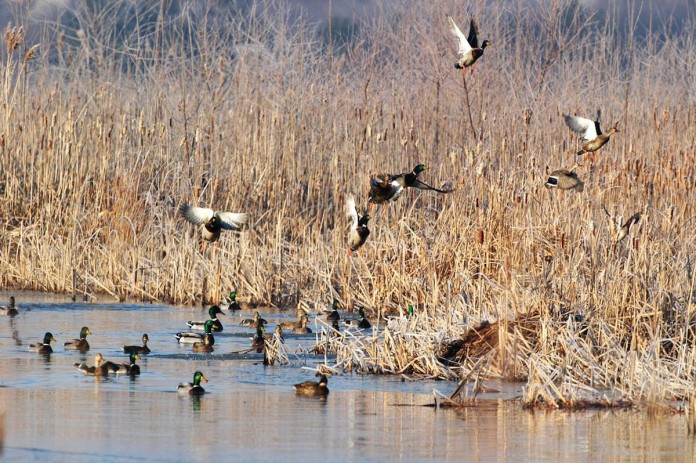News reports of mallard broods stopping traffic as they cross a road are cute and make good copy, but they leave the impression that breeding ducks in this part of the country are abundant.
Except for wood ducks, they are not.
Woodies breed throughout the East along wooded waterways and swamps, and their contribution to the continent’s wood duck population is significant. But the vast majority of North America’s ducks originate in the prairie potholes of Canada, the Dakotas, and Minnesota.
Good news
A recently published U.S. Fish & Wildlife Service report, Trends in Duck Breeding Populations 1955-2013, should encourage North American duck hunters.
Biologists use data obtained from aerial surveys by the U.S. Fish & Wildlife Service and the Canadian Wildlife Service to make population estimates, which are then used to formulate hunting season and bags limits for states and provinces.
The total duck population this year, excluding sea ducks, mergansers and wood ducks, was 45.6 million birds. That’s down 6 percent from last year, but still 33 percent higher than the long-term average.
Trends look good
Mallards, the most abundant duck in North America, came in at 10.4 million birds. That’s about the same as last year and 36 percent above the long-term average of 7.6 million.
Population estimates for other common ducks showed similar trends.
Gadwalls (3.3 million) maintained a population at 2012 levels, which is 80 percent above long-term levels. Wigeons (2.6 million) were up 23 percent above 2012 levels and similar to their long term averages.
Green-winged teal numbers (3.1 million) were similar to their 2012 numbers and 51 percent above their long-term average. Blue-winged teal (7.7 million) were down 16 percent this year, but up 60 percent over their long-term average.
Even diving duck numbers were strong this year. Redheads (1.2 million) and canvasback (800,000) numbers were similar to 2012 levels, but their population estimates were up 76 and 37 percent respectively over long-term averages.
Plenty of water
The simplest reason for duck breeding success this year is lots of water. The estimate for total number of ponds found on the survey area this year was 6.9 million. That’s 24 percent above the 2012 estimate and 35 percent above the long- term average.
Comparison
To put all these numbers in perspective, let’s look at data from 1994. In that year, the breeding duck survey counted 32.5 million ducks. And that was up 2 percent over the 40-year average. The mallard count in 1994 was 7 million.
Counts for other species in 1994 included gadwalls, 2.8 million; wigeons, 2.4 million; green-winged teal, 2.1 million; blue-winged teal, 4.6 million. Among divers, redheads struggled at 653,000, and canvasbacks totaled just 526,000.
When I reported these numbers in a column in 1994, I began with these words: “There’s finally good news from the prairie potholes of Canada and the northern plains states.”
This year’s numbers make the 1994 duck population look like species in crisis.
As mallards go…
An even closer look at mallards demonstrates that 2013 is one of their best years. Peak mallard years came in 1956 (10.4 million mallards), 1958 (11.2 million), and 1999 (10.8 million). That makes this year the third best ever for mallards.
And mallards are a good indicator species. What’s good for mallards is also good for many ducks and other wetlands species.
For comparison, the worst mallard years were 1965 (5.1 million), 1984 (5.4 million), and 1985 (5.0 million). The key to continental duck production is habitat and water. In drought years, production plummets, and there’s not much wildlife managers can do about it.
Snowmelt, rainfall, and the number of ponds are directly related to duck production. Wet years yield lots of ducks. Drought years depress production.
Several consecutive drought years can devastate duck numbers. That’s why population surveys are so important. U.S. and Canadian biologists use these surveys to adjust hunting season dates and bags limits to insure that too many ducks are not killed. Some years they actually close the season on some species.
Fortunately, duck populations are resilient. Wet years after drought years see rapid recovery. That’s why duck populations tolerate hunting pressure.
Duck conservation is pretty simple — give them habitat and water, and populations boom.













